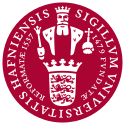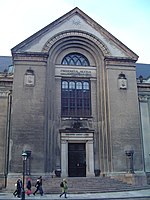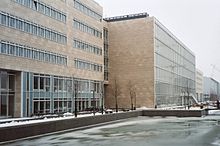University of Copenhagen
| University of Copenhagen | |
|---|---|

|
|
| motto | Coelestem adspicit lucem |
| founding | 1479 |
| Sponsorship | state |
| place | Copenhagen , Denmark |
| Rector | Henrik C. Wegener |
| Students | 38,615 (29,038 FTE ) (2016) |
| Employee | 9,763 FTE (2016) |
| Annual budget | 8.5 billion Danish kroner (2016) |
| Networks | 4EU + , ELLS , IARU , IAU , LERU |
| Website | www.ku.dk |
The University of Copenhagen ( Danish : Københavns Universitet , Latin : Universitas Hafniensis ) is the oldest and - in terms of the number of students - the second largest university in Denmark . The university buildings are now spread across the greater Copenhagen area , while the main and administrative buildings are still in the city center.
It was founded in 1479, making it the oldest university in Scandinavia after Uppsala University . Along with Aarhus University, founded in 1928 (the largest in Denmark), it is the most prestigious in the country.
The university is the University network International Alliance of Research Universities and the Euro League for Life Sciences at.
Faculties
There are six faculties :
- Faculty of Theology (Danish: teologi / abbr.TEOL)
- Legal Faculty (jurassic / abbr. JURA)
- Faculty of Social Sciences (samfundsvidenskab / abbr.SAMF)
- Faculty of Medicine (sundhedsvidenskab / abbr.SUND)
- Humanistic Faculty (humaniora / abbr.HUM)
- Faculty of Natural and Environmental Sciences (natur- og biovidenskab / abbr. SCIENCE)
The engineering sciences are not represented at the university.
History of the university
The university was founded by royal decree in 1479 under the name Universitas Hafniensis (from Hafnia , the old, Latinized name of Copenhagen). In addition to Roman Catholic theology , law, medicine and philosophy were initially taught. In 1537 the Lutheran Reformation reached the university, which was converted into a Protestant seminary. This date is now considered an alternative date of foundation and is also noted on the official seal of the university. Starting with the theological faculty in 1675, all faculties introduced examination exams until 1788, which from then on were a prerequisite for obtaining a degree.
Admiral Nelson bombed Copenhagen during the Napoleonic Wars in 1801, destroying almost all of the university buildings. Several new buildings - including today's main building - were inaugurated by 1836, and several new - especially technical - courses were introduced. The faculties were also fundamentally reformed by 1850, for example mathematics and natural sciences were split off from the philosophy faculty. In 1877 the KU accepted the first female student.
Between 1960 and 1980, the number of students jumped from 6,000 to over 25,000, which made it necessary to expand the equipment. As a result, a new campus was opened on the offshore island of Amager . In addition, important steps towards democratization and student participation were initiated from 1970 to 1973 , and the Bachelor's degree was introduced for almost all courses from 1990 to 1993 .
Two major restructurings followed in 2007 and 2012. On January 1, 2007, the Pharmaceutical University of Denmark and the Royal Veterinary and Agricultural University became part of the University of Copenhagen as the Pharmaceutical Faculty (Det Farmaceutiske Faculty / FARMA) and Environmental Science Faculty (Det biovidenskabelige Facet / LIFE) . On January 1, 2012, the Faculty of Pharmacy and the veterinary science part of the Faculty of Environmental Sciences were integrated into the Faculty of Medicine. The other parts of the environmental science faculty were merged with the natural science faculty (Det naturvidenskablige faculty / NAT) to form the natural and environmental science faculty.
Well-known lecturers and students
- Heinrich Louis d'Arrest (1822–1875), German astronomer
- Christian Ingerslev Baastrup (1885–1950), Danish radiologist
- Erasmus Bartholin (1625–1698), Danish scientist, taught mathematics in Copenhagen from 1656
- Thomas Bartholin (1616–1680), Danish physician, anatomist, mathematician, theologian, philosopher and philologist
- Niels Bohr (1885–1962), Danish physicist, Nobel Prize winner 1922
- Tycho Brahe (1546–1601), Danish nobleman, astronomer
- Johannes Bugenhagen (1485–1558), German theologian
- Arthur Christensen (1875–1945), Danish orientalist
- Magnús Eiríksson (1806–1881), Icelandic theologian and manuductor (see Manuduction ) at the University of Copenhagen from 1838 to 1847.
- Niels Christian Frederiksen (1840–1905), Danish economist
- Niels Ryberg Finsen (1860–1904), Danish doctor, Nobel Prize winner 1903
- NFS Grundtvig (1783–1872), Danish poet and founder of the Danish folkehøjskole
- Kenn Hansen (* 1980), Danish football referee
- Christopher Hansteen (1784–1873), Norwegian astronomer
- Martin Bille Hermann (* 1968), Danish diplomat
- Georg Heuermann (1722 / 1723–1768), German-Danish surgeon and physiologist
- Andreas Hojer (1690–1739), German-Danish historian and legal scholar
- Ludvig Holberg (1684–1754), Danish-Norwegian poet
- Björn Ibsen (1915–2007) Danish anesthetist and co-founder of intensive care medicine.
- Otto Jespersen (1860–1943), Danish linguist
- Wilhelm Johannsen (1857–1927), Danish botanist
- Søren Kierkegaard (1813–1855), Danish philosopher
- Casper Klynge (* 1973), Danish diplomat
- August Krogh (1874–1949), Danish doctor and zoologist, Nobel Prize winner; Student and professor at the University of Copenhagen
- Peter Wilhelm Lund (1801–1880), Danish zoologist and paleontologist
- Allan Roy Mackintosh (1936–1995), British physicist
- Peter Naur (1928–2016), Danish computer scientist and Turing Prize winner, student and professor at the University of Copenhagen
- Peter Vang Petersen (* 1952), Danish prehistorian, curator at the Danish National Museum
- Holger Christian von Reedtz (1800–1857), Danish politician, diplomat, historian and astronomer
- Ole Rømer (1644–1710), Danish astronomer, introduced the Gregorian calendar in Denmark
- Henrich Steffens (1773–1845), natural philosopher and poet
- Peter Ludwig Mejdell Sylow (1832–1918), Norwegian mathematician
- Hans Tausen (around 1494–1561), Danish Hebrew teacher at the university
- Thorvald Nicolai Thiele (1838–1910), Danish astronomer and actuary
- Johann Clemens Tode (1736–1806), German-Danish medic and rector from 1800 to 1805
- Hans Christian Ørsted (1777-1851), Danish physicist, chemist, namesake of the physical unit Oersted (Oe)
See also
Web links
- Homepage (Danish)
Individual evidence
- ↑ Om universitetet> Ledelse> Rector. Retrieved August 8, 2019 .
- ↑ Archived copy ( Memento of September 8, 2015 in the Internet Archive ) (English)
- ↑ Archived copy ( Memento from June 17, 2017 in the Internet Archive ) (English)
- ^ List of IAU Members. In: iau-aiu.net. International Association of Universities, accessed July 25, 2019 .
Coordinates: 55 ° 39 ′ 45 ″ N , 12 ° 35 ′ 17 ″ E



